FEATURES|COLUMNS|Coastline Meditations
Fleeting Light: Exploring the Non-dualistic Essence of All Things with American Artist Miya Ando
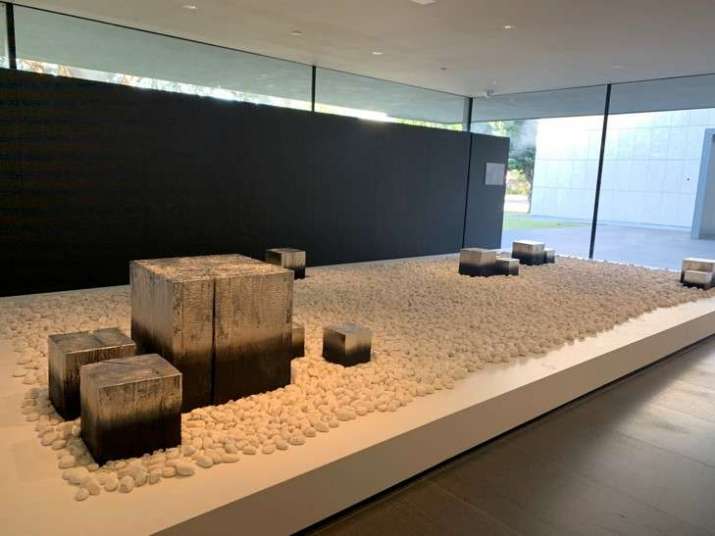 Ryōanji, 2019. Part of The Asia Society Exhibition, the piece is an homage to the garden at Ryōan-ji, a Zen temple in Kyoto. Image courtesy of N. Baker
Ryōanji, 2019. Part of The Asia Society Exhibition, the piece is an homage to the garden at Ryōan-ji, a Zen temple in Kyoto. Image courtesy of N. BakerMiya Ando is an American artist who is known for exploring the concepts of temporality and impermanence in her artwork. I was fortunate to meet Ando at her Los Angeles studio (she also has a studio in New York), and I was immediately struck by the combination of stillness and movement that appears to flow out of her paintings, sculptures, and installations. Ando’s specialty is the transformation of surfaces, and her studio boasts pieces made from a variety of materials, including metal, wood, and glass, which she has chemically altered to attain a desired effect. The time of day, the quality of light, and the angle from which the pieces are viewed are all components that affect how her art is perceived—because of this, they are never experienced in exactly the same way. Ando laughs as she shares that creating this effect is no easy task. “I tried so many times, there have been many ugly ducklings!”
Ando, whose grandfather was the head priest of a Nichiren Buddhist temple in Okayama, Japan, spent part of her childhood surrounded by priests, and as a young adult she studied Buddhism and Eastern Religions at Berkeley and Yale. She is the 16th generation in a lineage of Bizen sword-makers, a refined craft that she studied in Japan under a master metalsmith. While the connection between her sword-making ancestors and her Buddhist upbringing may not be apparently obvious, Ando explains that the samurai tradition is intrinsically connected to religion. She points out that the tang (i.e. the handle) of a samurai sword usually contains a religious engraving, such as depictions of lotus flowers, bodhisattvas, or bonji (Sanskrit characters that represent Buddhist deities). It was therefore natural that—as the need for fighting samurai declined in Japan—many of those in the sword-making industry became priests in the Buddhist temples to which they belonged.
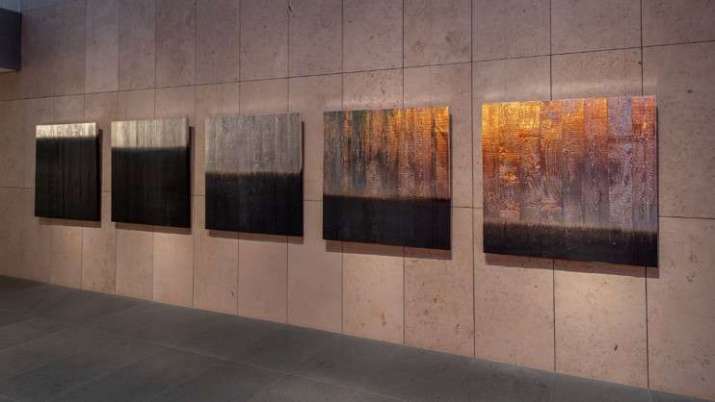 Emptiness is Form, Form is Emptiness, 2019. Image courtesy of N. Baker
Emptiness is Form, Form is Emptiness, 2019. Image courtesy of N. BakerAs a child, Ando spoke Japanese first and later learned English when she started school in Santa Cruz, on the West Coast of the United States. Because of this culturally diverse upbringing, she revels in the fact that religious imagery and iconography can convey an abstract thought, without requiring the knowledge of a specific language. “There are multiple ways of saying things. What captivated me [as a girl] is that I lived in this temple, and I saw this imagery that imparts information. I guess I was yearning, as a bi-racial person, to find something that had a democracy to it and is welcoming.”
Through her art, Ando pays homage to her metalsmith ancestors and to her Buddhist lineage by exploring the industrial materials and the thought-provoking concepts to which she was exposed. Ando shares that she feels privileged to have lived with a Buddhist priest in their simplistic and traditional tatami house. “I have been privy to some very traditional and beautiful thought. And I yearn to preserve and pay homage to this by trying to respect that tradition, but I also carry it with me to this contemporary time, and to the future. That’s what I hope my work will be remembered for.”
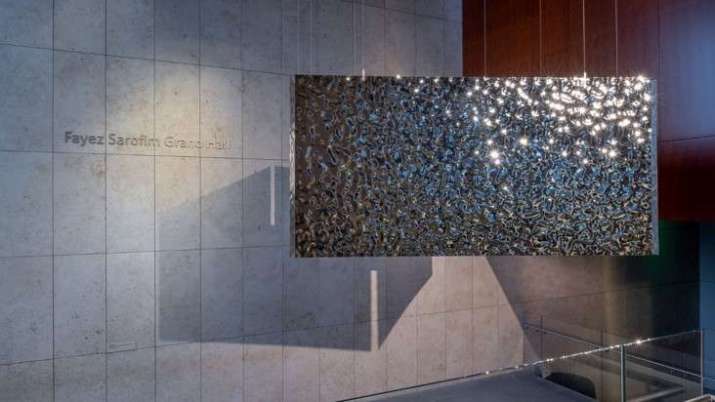 Emptiness is Form, Form is Emptiness, 2019. Image courtesy of N. Baker
Emptiness is Form, Form is Emptiness, 2019. Image courtesy of N. BakerAndo’s current exhibition at the Asia Society Texas Center, titled “Form is Emptiness, Emptiness is Form,” is based on the Heart Sutra. She points out that this very sparse and obscure sutra, which contains only 270 Japanese kanji characters, was one of the rare occasions when the bodhisattva Avalokiteshvara made a speech. “What does it mean? Everything, me, you, this metal chair, is in a constant flux, although it looks static. It’s the idea that there is no intrinsic difference between something that has form and something that doesn’t have form.”
The exhibition showcases the transformation of materials, including light, water, wood, and metal. Ando has altered these materials by natural physical treatments (such as sculpting and charring), as well as by chemical and electrical processes. Working with elementary materials is important to the artist, because nature is a universal language to which everyone can relate. She adds that nothingness and emptiness—a core idea in Buddhist thought—forms a substantial part of her work.
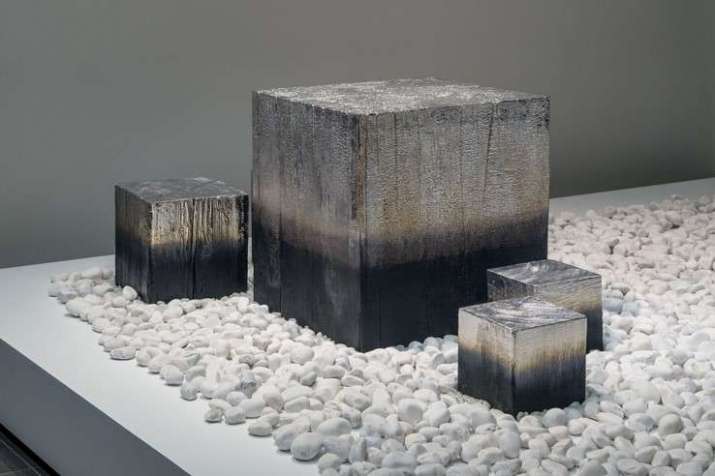 Emptiness is Form, Form is Emptiness, 2019. Image courtesy of N. Baker
Emptiness is Form, Form is Emptiness, 2019. Image courtesy of N. Baker“This idea is very ancient, and Buddhists have been thinking about it for thousands of years. When they started to do particle accelerators in quantum physics, they discovered that at the very tiniest subatomic level of every particle is vibrating energy. There is no seed, no grain of sand; there is nothing that is very fixed. Particles make up everything, and in each particle it is just movement. It is so interesting that this principle in quantum physics—which they have now been able to prove—Buddhists have been talking about for this great long period of time.”
Through her art, Ando can explore abstract philosophical and scientific concepts—such as impermanence and fleeting temporality—in a way that is accessible. “I have an affinity and a love for science. I find the comparison of traditional Eastern thought and Western science interesting, and I like to explore it through the materials which are part of my family, my identity.”
When asked how audiences have responded to her work, Ando highlights that the beauty of art is that it is a silent means of communication. She makes something and puts it up, and the audience may not have any idea about where the piece came from, nor that “little miss Ando” grew up in a temple and was raised by swordsmiths. “I don’t want to ever be in a position where I tell someone what to think, or how to think. I don’t need to tell anyone what to think, they already have their own ability to place things into their own contexts, and that freedom is very important to maintain. It’s a silent dialogue and their silent reaction to the work is just as important as when I make it.”
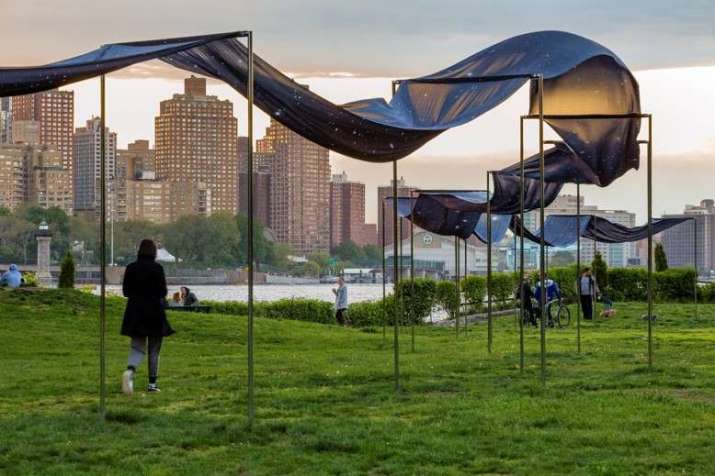 Ginga (The Silver River in Heaven), 2019. Printed fabric, stainless steel, 58 x 2400 inches. Image courtesy of Nick Knight
Ginga (The Silver River in Heaven), 2019. Printed fabric, stainless steel, 58 x 2400 inches. Image courtesy of Nick KnightAndo recalls when a Japanese collector looked at some of her very spare, indigo paintings in her New York studio. After a long period of time, he said: “Miya, I want to have these paintings of the lake.” This came as a surprise to Ando, who had never said the word lake, nor had she thought “lake.” The collector noticed her surprise and explained, “I know they are a lake, because I grew up near a lake. And when I was a little boy, this is what it felt like.”
“I prefer this kind of dialogue rather than a soliloquy or monologue where I’m saying, ‘the artwork is about impermanence. . .’ That is my reading and my reason for making it, but it doesn’t mean that it is the only reason, or even the correct reading. Because everyone has something they bring when they view the works. Mostly people have said to me that the works make them feel peaceful or calm, which is beautiful. My praised state of mind is tranquility. Not ebullience or joy, but equanimity. And to be able to create a scenario that imparts that to people, I feel very happy to hear that.”
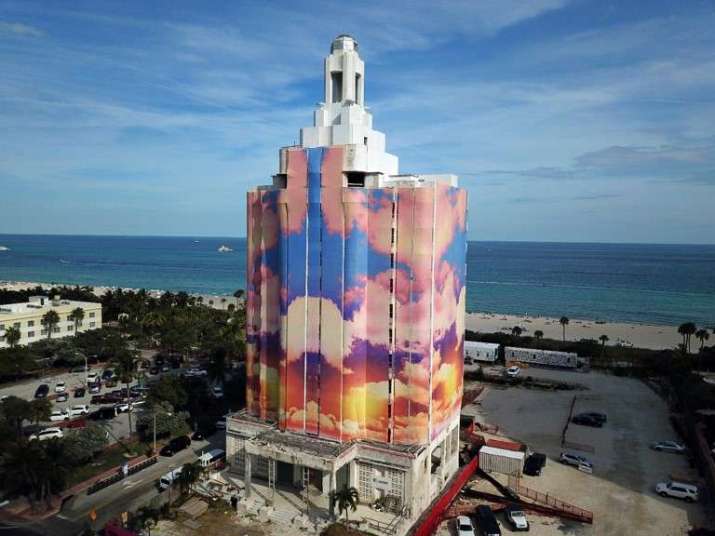 Sora Versailles, 2018. The Japanese kanji 空 is pronounced “sora,” meaning sky or heaven. This word also has another reading, pronounced “kū,” meaning “emptiness or void.” Image Courtesy of Kerry McLaney
Sora Versailles, 2018. The Japanese kanji 空 is pronounced “sora,” meaning sky or heaven. This word also has another reading, pronounced “kū,” meaning “emptiness or void.” Image Courtesy of Kerry McLaneyIn the current divisive socio-political climate, Ando points out, we tend to focus on how we are all very different. “I really am looking for bridges between people, and I really want to find that because in some places we are exactly the same. And I think that the recognition that life is transitory, it does not have to be a somber thing. In fact, I think it’s actually quite beautiful to recognize that this is all impermanent. We have this semi-short period of time to enjoy, and the recognition of that moment, it’s a different way to think about things. And the metal expresses that very beautifully, just intrinsically by itself. It’s a vehicle. Because of the way that the light moves through it.”
The exhibition Form is Emptiness, Emptiness is Form is on display at the Asia Society Texas Center until 29 March 2020.
See more
Asia Society Texas Center Opens New Installation "Form is Emptiness, Emptiness is Form" by Artist Miya Ando in Texas Debut (The Asia Society Texas)
Crystals in Art: Artists Coming to Crystal Bridges (Crystal Bridges Museum of American Art)
Miya Ando
Related features from Buddhistdoor Global
Sculpting Silence: The Artistic Meditations of Elizabeth Turk
Kiyomizu-dera: Kyoto’s Temple of Pure Water in Legend and Art
Art, Magic, and Hidden Realms
Reflections on Time and Space: The LED Installations of Tatsuo Miyajima
Zen Buddhist Aesthetics in the Works of Joanne Julian














